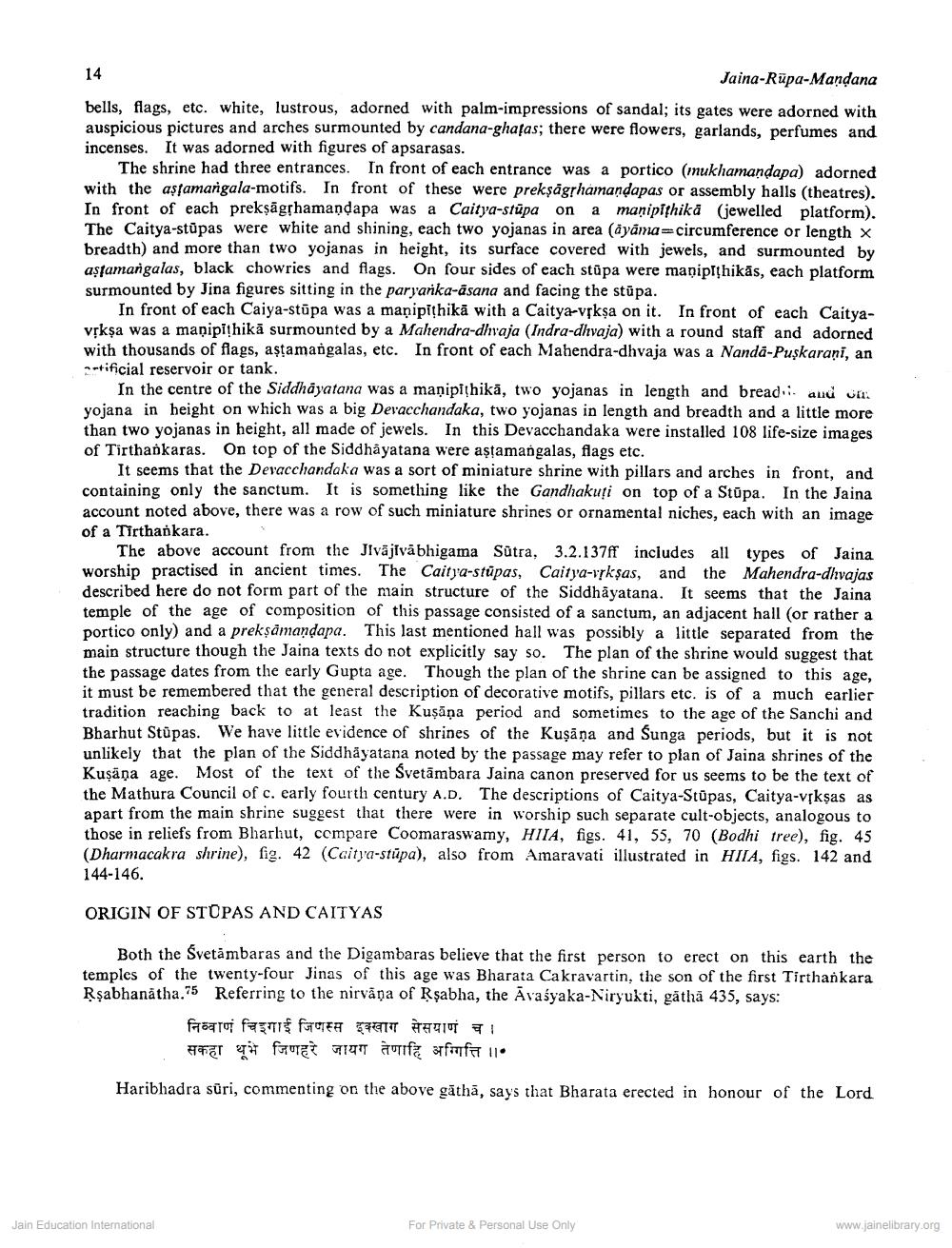________________
14
Jaina-Rupa-Mandana bells, flags, etc. white, lustrous, adorned with palm-impressions of sandal; its gates were adorned with auspicious pictures and arches surmounted by candana-ghatas; there were flowers, garlands, perfumes and incenses. It was adorned with figures of apsarasas.
The shrine had three entrances. In front of each entrance was a portico (mukhamandapa) adorned with the asfamangala-motifs. In front of these were preksägshamandapas or assembly halls (theatres). In front of each preksāgphamandapa was a Caitya-stupa on a manipithikā (jewelled platform). The Caitya-stūpas were white and shining, each two yojanas in area (ayamam circumference or length x breadth) and more than two yojanas in height, its surface covered with jewels, and surmounted by astamangalas, black chowries and flags. On four sides of each stūpa were manipithikās, each platform surmounted by Jina figures sitting in the paryarika-asana and facing the stūpa.
In front of each Caiya-stūpa was a manipithikā with a Caitya-vskṣa on it. In front of each Caityavrkșa was a manipihikā surmounted by a Mahendra-dhaja (Indra-dhvaja) with a round staff and adorned with thousands of flags, astamangalas, etc. In front of each Mahendra-dhvaja was a Nanda-Puşkarani, an -tificial reservoir or tank.
In the centre of the Siddhayatana was a manipithikā, two yojanas in length and bread.i au un yojana in height on which was a big Devacchandaka, two yojanas in length and breadth and a little more than two yojanas in height, all made of jewels. In this Devacchandaka were installed 108 life-size images of Tirthařkaras. On top of the Siddhayatana were aştamangalas, flags etc.
It seems that the Devacchandaka was a sort of miniature shrine with pillars and arches in front, and containing only the sanctum. It is something like the Gandhakuti on top of a Stupa. In the Jaina account noted above, there was a row of such miniature shrines or ornamental niches, each with an image of a Tirthankara.
The above account from the Jivājīvābhigama Sutra, 3.2.137ff inciudes all types of Jaina worship practised in ancient times. The Caitya-stupas, Caitya-vykşas, and the Mahendra-dhvajas described here do not form part of the main structure of the Siddhayatana. It seems that the Jaina temple of the age of composition of this passage consisted of a sanctum, an adjacent hall (or rather a portico only) and a preksämandapa. This last mentioned hall was possibly a little separated from the main structure though the Jaina texts do not explicitly say so. The plan of the shrine would suggest that the passage dates from the early Gupta age. Though the plan of the shrine can be assigned to this age, it must be remembered that the general description of decorative motifs, pillars etc. is of a much earlier tradition reaching back to at least the Kuşāņa period and sometimes to the age of the Sanchi and Bharhut Stūpas. We have little evidence of shrines of the Kuşāņa and Sunga periods, but it is not unlikely that the plan of the Siddhayatana noted by the passage may refer to plan of Jaina shrines of the Kuşäna age. Most of the text of the Svetāmbara Jaina canon preserved for us seems to be the text of the Mathura Council of c. early fourth century A.D. The descriptions of Caitya-Stūpas, Caitya-vīkşas as apart from the main shrine suggest that there were in worship such separate cult-objects, analogous to those in reliefs from Bharhut, compare Coomaraswamy, HIIA, figs. 41, 55, 70 (Bodhi tree), fig. 45 (Dharmacakra shrine), fig. 42 (Caitya-stupa), also from Amaravati illustrated in HITA, figs. 142 and 144-146.
ORIGIN OF STOPAS AND CAITYAS
Both the Svetambaras and the Digambaras believe that the first person to erect on this earth the temples of the twenty-four Jinas of this age was Bharata Cakravartin, the son of the first Tirthankara Rşabhanātha.75 Referring to the nirvāņa of Rşabha, the Avaśyaka-Niryukti, gātha 435, says:
निव्वाणं चिइगाई जिणस्स इक्खाग सेसयाणं च । सकहा थूभे जिणहरे जायग तेणाहि अग्गित्ति ।।.
Haribhadra sūri, commenting on the above gāthā, says that Bharata erected in honour of the Lord
Jain Education International
For Private & Personal Use Only
www.jainelibrary.org




